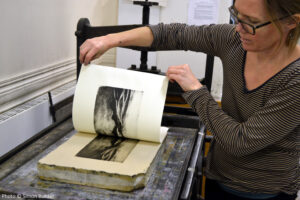Lithography
History, Advantages and Disadvantages
Lithography, a cornerstone of modern printing, emerged in the late 18th century and revolutionized the way images and text were reproduced.

Birth of Lithography:
The story begins with Aloys Senefelder, a German playwright and actor in the late 1700s. Facing financial constraints in publishing his theatrical works, Senefelder sought a cost-effective alternative to traditional printing methods like letterpress and intaglio.
In 1796, while experimenting with various materials, Senefelder discovered the principle of lithography. He found that by using a greasy substance (wax, oil, or fat) on a smooth limestone slab, he could create a surface where ink would adhere to the grease but be repelled by the wet, non-greasy areas. This technique allowed for the transfer of images or text onto paper.
Rise to Prominence:
Senefelder coined the term “lithography” from the Greek words ‘lithos’ (stone) and ‘graphein’ (to write). Initially, lithography gained attention for its application in the theater, as Senefelder used it to print scripts and scores for his plays.
The technique’s appeal extended beyond theater. Artists recognized lithography’s potential for creating high-quality reproductions of their works, leading to its adoption in the art world. The ability to draw directly on the stone surface with a greasy medium, such as a lithographic crayon, offered artists a new creative avenue.
Technological Advancements:
Throughout the 19th and 20th centuries, lithography underwent technological advancements. Senefelder’s original limestone plates gave way to more versatile materials like metal plates and offset lithography, which involved transferring images from a plate to a rubber blanket before printing onto the final surface, typically paper.
Commercial Impact:
Lithography’s impact expanded beyond art. It became integral in commercial printing due to its ability to produce high-quality, mass-reproducible prints. Posters, newspapers, books, packaging, and advertisements relied heavily on lithography for its cost-effectiveness and quality.
Modern Lithography:
As technology progressed, lithography evolved further. Today, modern lithographic processes involve computer-to-plate systems, where digital files are directly transferred to printing plates. This advancement streamlined the process, allowing for more precise and efficient printing.
Advantages of Lithography:
Cost-Effectiveness: Once the setup is done, lithography can produce high volumes of prints at a relatively low cost per unit.
Versatility: It accommodates various surfaces, from paper and cardboard to wood and metal.
High-Quality Prints: Lithography can reproduce fine details and maintain high-quality images consistently.
Large Print Runs: It’s suitable for mass production, making it a favorable choice for commercial printing.
Chemical Stability: The chemicals used in lithography are relatively stable, allowing for more extended periods of use without degradation.
Disadvantages of Lithography:
Complex Setup: Initial setup can be time-consuming and require skilled technicians to prepare the plates or stones for printing.
Limited Texture: Lithography is best suited for flat surfaces, which limits its ability to create textures or three-dimensional effects.
Sensitivity to Environment: Changes in temperature and humidity can affect the printing process, causing inconsistencies in the output.
Plate Wear: Continuous printing can cause wear and tear on the plates or stones, leading to a degradation in print quality over time.
